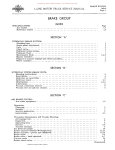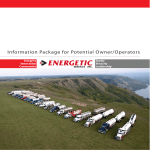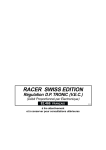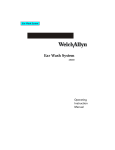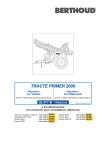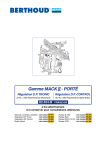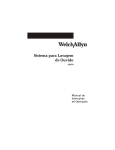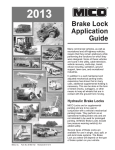Download BENDIX BW1399 User's Manual
Transcript
The three phases of tests presented here have been designed to discover the presence of both vacuum and hydraulic fluid leakage and sluggish performance of the brakes. The entire system from the vacuum service to the wheel cylinder or caliper can be easily checked in a relatively short period of time by performing these tests. When working on or around brake systems and components, the following precautions should be observed: 1. Always block vehicle wheels. Stop engine when working under a vehicle. Keep hands away from chambers; they may apply as system pressure drops. 2. Never connect or disconnect a hose or line containing pressure; it may whip. Never remove a component or pipe plug unless you are certain all system pressure has been depleted. 3. Never exceed recommended pressure and always wear safety glasses. 4. Never attempt to disassemble a component until you have read and understand recommended procedures. Some components contain powerful springs and injury can result if not properly disassembled. Use only proper tools and observe all precautions pertaining to use of these tools. 5. Use only genuine Bendix replacement parts and components. A. Only components, devices and mounting and attaching hardware specifically designed to use in hydraulic brake systems should be used. B. Replacement hardware, tubing, hose, fittings, etc. should be of equivalent size, type and strength as the original equipment. 6. Devices with stripped threads or damaged parts should be replaced. Other than drums and rotors, repairs requiring machining should not be attempted. 7. For cleaning brake parts, use only new DOT 4 brake fluid, isopropyl alcohol or clear methylated spirits. Do not use mineral base cleaning solvents such as gasoline, kerosene, carbon tetrachloride, acetone or paint thinner - these will damage the rubber parts. 8. Bendix recommends that for optimum results and safety, worn units should be replaced by new units. If, however, it is decided to service a used component, particular attention should be paid to the following, but in any case of doubt replace the unit or seek professional advice. DATE: BEFORE GETTING STARTED TRUCK Please note that the tests presented here are performed with the vehicle stationary. They must not be interpreted as overruling the importance and necessity of functional dynamic controllability tests and other testing required in assuring vehicle safety and performance. MECHANIC: While in many cases a problem can be found and corrected early in the testing procedure, it is generally recommended that all three phases of testing be completed to assure that the entire system is in good working order. To perform these tests it is necessary to obtain both a vacuum and hydraulic pressure gauge. The hydraulic gauge should be capable of readings up to 2000 P.S.I. while the vacuum gauge should have a range up to 30 inches of mercury. Troubleshooting The Vacuum Hydraulic Brake System TROUBLESHOOTING THE VACUUM HYDRAULIC BRAKE SYSTEM PHASE I – VISUAL INSPECTION Brake Fluid Type Boiling Point Dry Boiling Point Wet DOT #3 401°F 284°F DOT #4 446°F 311°F DOT #5 (silicone) 500°F 500°F With the master cylinder cover off, have an assistant slowly make a full brake application while observing the fluid in the reservoir. CAUTION. Wear eye protection and do not allow fluid to contact vehicle's painted finish. A small spurt or geyser at the beginning of the brake application followed by continued fluid turbulence indicates internal master cylinder leakage. Repair or replace. If the fluid remains calm after initial spurt, continue to Phase II Testing. GENERAL PHASE II – HYDRAULIC SYSTEM TESTS Phase I visual inspection procedures should reveal the most common problems found in a hydraulic brake system. The inspection steps are presented in the order in which they are most easily performed. INSPECTION 1. Look for signs of fluid leakage at connection points as well as around wheel cylinder calipers, the master cylinder and hydrovac. Inspect disc brakes caliper piston boots for tears or deterioration. 2. Inspect the master cylinder pedal and linkage for binding, bending or damage. Lubricate rotating and sliding components with a rubber compatible lubricant. 3. Inspect the foundation brakes for proper adjustment and adjust if necessary. 4. Start engine and have assistant make several brake applications while visually inspecting all hydraulic and vacuum lines, hoses, and clamps for kinking, chafing, damage, corrosion and signs of collapsing or "ballooning". 5. Remove the master cylinder reservoir cover and check the fluid level. Refill as necessary. While the cover is off, look for discoloration, cloudiness, and "gumming" of the fluid. Also look for corrosion on any part in contact with the fluid. If any of these conditions are found, the system should be drained, bled, flushed and refilled with the proper type of brake fluid for the application. DO NOT MIX HYDRAULIC FLUID AND BRAKE FLUID. "GUMMING" OF FLUID AND DAMAGE TO COMPONENT SEALS WILL RESULT. Federal Motor Vehicle Safety Standard #116 divides brake fluids into three categories with the primary difference being the fluid boiling points. GENERAL 1. With the engine off and brakes not applied, install a 0-2000 p.s.i. hydraulic gauge at the wheel cylinder or caliper and bleed air from the gauge and its connecting line. NOTES: A. The gauge can usually be installed by removing the wheel cylinder bleed screw. B. When the vehicle is equipped with a dual or "split" brake system, a gauge must be installed in each side of the system, i.e.; one gauge in a front axle brake and one gauge in a rear axle brake. Alternatively, the tests can be performed twice, once for the front axle brakes and again for the rear axle brakes. 2. With the engine idling, apply and release the brakes several times. Note that the pressure is registered on the gauge with the brakes applied and that each time the brakes are released the gauge returns to 0 p.s.i. NOTE: In systems where a residual check valve is used the pressure will not return to 0 p.s.i. Between 3 and 50 p.s.i. pressure will remain when the brakes are released. RESIDUAL CHECK VALVES MUST NOT BE USED TO HOLD PRESSURE ON A DISC BRAKE CALIPER. 3. With the engine idling make a rapid, full brake application and hold it applied while observing one of four gauge reactions. A. Pressure instantly rises to between 1000 and 2000 p.s.i. and remains constant while brakes are applied. Hydraulic System Okay Problem is most likely in Vacuum System or Booster Perform Phase III Vacuum System Tests C. Pressure rises slowly but remains constant while brakes are held applied. Final pressure reading may be very low or may be between 1000 and 2000 p.s.i. Record pressure reading here if it is less than 1000 p.s.i. ______________________. Hydraulic System Okay Problem is most likely in Foundation Brakes Check Foundation Brakes Mechanical Parts For Example: (1) Drum or rotor condition (2) Backing or anchor plate condition While applying and releasing brakes, inspect hydraulic lines and hoses for kinks, bends, "ballooning" and restrictions that may not have been found in Phase I inspections. Replace as necessary. Release brake application, then remove atmospheric air hose from vacuum booster control valve. (NOTE: This is the hose running between the booster and its externally mounted filter generally found in the cab.) Make a full and rapid brake application and again observe gauge at wheel. (3) Shoe and lining condition (4) Correct lining friction (5) Caliper sliding surfaces (6) Worn, missing or damaged part (7) Wheel bearings Hydraulic pressure rises instantly to between 1000 and 2000 p.s.i. Hydraulic pressure rises slowly to same pressure recorded above. Repair or replace atmospheric air filter and/or connecting hose fittings. Return to beginning of Step 3 and retest. Perform Phase III Vacuum System Tests B. Pressure instantly rises and remains constant while brakes are held applied but pressure does not reach a minimum 1000 p.s.i. D. Pressure rises instantly to between 1000 and 2000 p.s.i. but begins to drop while brakes are held applied. Turn off engine. Make 10-15 full brake applications to get rid of all vacuum. Make and hold a full brake application and observe gauge at wheel. Pressure valve is not important. Watch for a pressure drop. Pressure rises instantly and remains constant while brakes are held applied. Pressure rises instantly but begins to fall while brakes are held applied. Hydraulic system okay. Vacuum leakage most likely causing the pressure drop. Vacuum system probably not causing pressure drop. Hydraulic leakage most likely causing pressure drop. There are two possible gauge results; proceed to the correct heading and continue testing. A. Vacuum gauge reading is 16 inches of mercury or higher. Vacuum reaching booster is okay. Shut off engine and note any change in vacuum gauge. The following are maximum acceptable leakage limits: 1. Vacuum system with separate vacuum reservoir; a drop of no more than 2" HG in 60 seconds. Perform Phase III Vacuum System Checks. Perform Steps 1, 4, 5 of Phase I Visual Inspection again. Return to beginning of Step 3 and retest. 2. Vacuum system without separate vacuum reservoir; a drop of no more than 2" HG in 15 seconds. Leakage is okay. Proceed to Step 3 and continue testing. PHASE III – VACUUM SYSTEM TESTS Leakage NOT okay. To pinpoint leakage source, reinstall gauge at positions indicated in Figure 3 and retest at each position. Begin at position #3 to test hose between check valve and vacuum source. Repair or replace components ahead of gauge when unacceptable leakage is noted. Continue testing until leakage checks okay at position #1. Leakage is okay. Proceed to Step 3 and continue testing. B. Vacuum gauge reading is less than 16 inches of mercury. Insufficient vacuum is reaching the booster. GENERAL 1. Remove vacuum line from booster control valve section and install a vacuum gauge with a range of 0-30 inches of mercury in the end of the line. (Refer to Figure 3 Gauge Position #1.) 2. Start engine and allow to idle for several minutes to allow vacuum gauge reading to stabilize, then read gauge. Vacuum should be a minimum of 16 inches of mercury. Record gauge reading here _________________" HG for use later. Shut off engine. Connect vacuum gauge at the source of vacuum on engine which is position #2 in Figure 3. Start engine and idle. Vacuum registered on gauge should be 16 inches of mercury or higher. Record reading here: _____________________" HG. 3. Reinstall vacuum hose at control valve of booster and tee in vacuum gauge. Start engine and build vacuum. Read gauge and compare to gauge reading recorded in first part of Step #2. (Refer to Figure 4.) Reading is same, booster okay. Vacuum less than 16 inches of mercury. Repair engine or replace vacuum pump if so equipped, then retest vacuum. Remove gauge from position #2 and reconnect hose to vacuum source. Vacuum is 16 inches of mercury or greater. Problem is most likely restricted lines/devices or excessive leakage. Refer to Figure 3 and reinstall gauge at positions 3, 4, 5, 6 & 1 in that order. Retest vacuum at each position. If vacuum is less than 16" HG at any position, repair or replace hose or component between current and last gauge position. Continue testing until 16" HG or better is noted at position #1. Reconnect vacuum gauge at position #1 as illustrated in Figure 3. Retest vacuum system beginning with Step #1. Reading is lower. Booster is leaking vacuum. Repair or replace and retest. With engine idling make 10 rapid brake applications and note the time required for vacuum to recover. The following are maximum acceptable limits. A. Vacuum system with separate vacuum reservoir; vacuum rise to 16" HG in 30 seconds or less. B. Vacuum system without separate vacuum reservoir; vacuum rise to 16" HG in 15 seconds or less. Recovery time is acceptable. Remove gauge and return vehicle to service. Recovery time not acceptable. Check hose, clamps, fittings. Repair or replace if required and retest. NOW – The most complete stock of original equipment replacement parts for all medium truck and school bus hydraulic brake systems. SEE YOUR BENDIX PARTS OUTLET FOR: POWER BRAKE DISC BRAKE DRUM BRAKE • Hydrovacs • Calipers and Repair Kits • Vacuum Pumps • Hardware Kits • Wheel Cylinders and Repair Kits • Hydromax • Rotors • Air-paks • Disc Pads • Master Cylinders and Repair Kits • Pistons • Detail Parts • Anchor Supports • Brake Lining • Power Brake Repair Kits Also • Brake Hose & Tubing • Fittings • Brake Fluid • Vacuum Hose THE AIR AND HYDRAULIC BRAKE EXPERTS BW1399 © 2003 Bendix Commercial Vehicle Systems LLC All rights reserved. 2/2003 Printed in U.S.A.






